Advertisement
USEC Inc., the company building the American Centrifuge Plant (ACP) to enrich uranium at Piketon, OH, announced it will file for bankruptcy in the first quarter of 2014. USEC said they are restructuring to pay off $530 million in debts to bondholders.
Unbelievably, the bankruptcy did not end government subsidy for the ACP.
* Just hours after USEC announced bankruptcy, the U. S. Dept. of Energy (DOE) announced it would give the company $30 million to keep the ACP alive—around $10 million per month for the next 3 months.
* In an article critical of the DOE’s subsidy decision, the online stock market news 4-traders wrote about how USEC, on the same day as the bankruptcy, announced that they are seeking new investor money because of a “National Security Train Program” utilizing ACP technology to be funded by the government for not less than $750 million. No official DOE or other government documents could be found mentioning a “National Security Train Program,” and neither DOE nor USEC would comment on the program.
USEC has put about $2.5 billion, much of this subsidized by the DOE, into the ACP. Technology used by USEC at the ACP was canceled by the Reagan administration because it was outdated even at that time. The ACP missed its deadline for operating its lead (trial centrifuges) cascade way back in 2006, with a serious accident in 2012 damaging six centrifuges and rupturing one. While DOE is now saying that operation of the lead cascade has been accomplished, skeptics aren’t convinced as to its viability.
In the same bankruptcy document it filed with the Securities and Exchange Commission, USEC conceded that there is no market for the enriched uranium that the ACP would produce. Worldwide there is a glut of capacity to enrich uranium.
The real reason for subsidizing the failed ACP is for a “domestic source” of enriched uranium. Foreign ownership of an enrichment facility would make it difficult for the U.S. to switch from making low-enriched uranium for power plants to making high-enriched uranium for nuclear weapons. The power of the man-behind-the-curtain, the U.S. military-industrial complex, is exposed because the DOE must have a rationale for subsidizing the ACP. Even such a secretive move as switching from making enriched uranium for nuclear power to making it for nuclear weapons is now being openly discussed.
In true pork-barrel fashion, many Ohio federal and state legislators are supporting the gifts to USEC. Ohio Senators Sherrod Brown and Rob Portman have strongly supported every subsidy that has and could possibly come down the Pike. In supporting the latest gift to USEC, Brown said that the ACP project could create about 4,000 jobs. This time-honored job-inflating technique can be compared to the reality of a gaseous centrifuge uranium enrichment plant opened in 2010 by URENCO USA in New Mexico, which has 236 current employees and had less than 1000 during construction.
Prominent Republicans such as House Speaker John Boehner from Ohio pushed aggressively for DOE to give a $2 billion loan guarantee to USEC to finish the ACP at the same time they were roundly criticizing DOE for its loan to Solyndra, the failed solar energy company that left taxpayers holding the bag for $500 million.
On Dec. 16 the New York Times had an article quoting USEC as saying the final cost of the ACP will be $6.5 billion, to be completed by 2017, whereas initially the cost was to be $1.7 billion and completed by 2005.
In Nov. 2013 the Washington Examiner reported in its Enrichment at the Public Till series that USEC has spent up to $5 million a year on lobbying, even when the company's worth was as low as $18 million.
Current U.S. Secretary of Energy Ernest Moniz was a paid member of USEC's strategic advisory council from 2002 to 2004.



